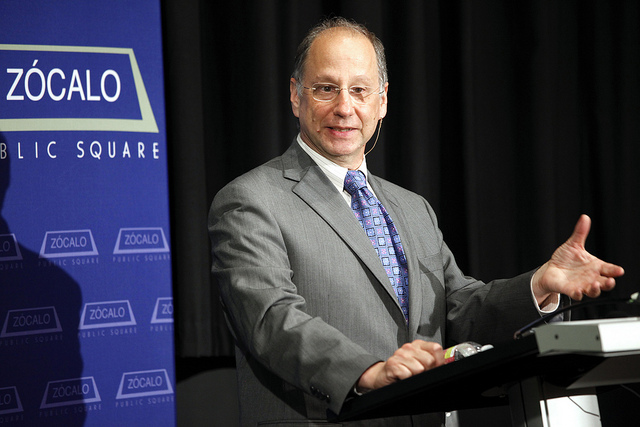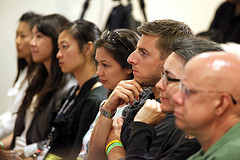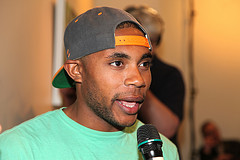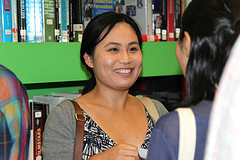
“Knowledge is in crisis,” David Weinberger told a crowd at the Goethe Institut Los Angeles. “We can look at any of the most secure, visible incarnations of knowledge in our culture, and, very likely, that incarnation is trembling, it’s falling over, it’s shattering, it’s not in good shape.”
The Encyclopedia Britannica has gone out of print; no one knows what a newspaper will look like 10 years from now; and the library’s future is just as uncertain.
But this isn’t a crisis we have to fear. Rather, it’s a really rapid–even exciting–change, said Weinberger, who gathered his thoughts in a new book called Too Big to Know: Rethinking Knowledge Now That the Facts Aren’t the Facts, Experts Are Everywhere, and the Smartest Person in the Room Is the Room.

Historically, knowledge in the Western world has been characterized by three things: 1. It is filtered–the result of sifting through public opinion for the truth. 2. It is settled. We’ve driven out all reasonable disagreement before we consider something a fact. 3. It is orderly. We know what a thing is because we know its place in the world order. This sort of knowledge helped us deal with a world that is “too big to know” and made the acquisition of knowledge efficient for our small but hungry brains.
The media by which we obtained knowledge reflected these three qualities of knowledge. Books were traditionally filtered by the publishing process: Not all manuscripts become books, and not all books make it into libraries. Print in general helped drive out uncertainty or disagreement: “Knowledge is settled just in the way ink settles into paper.” And libraries were organized in an orderly manner: Each book is filed by a single subject.
But books are a disconnected medium; a physical book is physically disconnected from every other book by design. We consult footnotes, but the idea of a book is that you don’t need to read a second or third book to understand the one in your hands at that moment. An author designs a topic so that it will fit between two covers.
By contrast, our new medium of knowledge is the network, and it is immensely connected. The blue underlined text of the hyperlink “is a new form of punctuation,” said Weinberger. With a flick of a finger, we can connect the text before us with billions of pages from around the world.

“It’s my hypothesis that therefore the properties of knowledge are becoming properties of this new medium, which is very different from the old medium,” said Weinberger.
Networks have already changed scientific discovery and dissemination. Einstein would submit a paper to a journal, at which point it would be reviewed by high-level physicists. Only then might it be published–and, if the author was lucky, the article might eventually merit a blurb in a national newspaper. But, in 2011, when a team of scientists set out to disprove Einstein’s theory of relativity, they did so on an open source website, arxive.org, where anyone could post data. They turned out to be wrong, but Weinberger said that the differences, disagreements, and elaborations that their paper spawned on the Internet added value and richness to the knowledge. Anyone could access not just their discovery but commentary by and for scientists and laypeople.
The Internet has also upended our focus on the ordering of knowledge. In the 19th century, scientists spent a lot of time arguing about what type of animal the platypus–a mammal with a bird’s beak that lays eggs–was. We wouldn’t waste time with that argument today, said Weinberger, because on a site like EOL.org–Encyclopedia of Life–you can search for a platypus under whatever category you believe to be the right one and specify how you want to see the animal categorized. The Internet “allows us to talk about the same thing in different terms–but to understand that we’re talking about the same thing,” said Weinberger. And even if we disagree about what the platypus is, we can still collaborate around and discuss the animal.
The process of software development has also taught us a great deal about how we learn. If you Google a programming language, you’ll find thousands of tutorials. If you experience a software problem, you can ask a question that someone has probably asked before–and find that many people have already answered your question, rated those answers, and clarified them. Developers are increasingly writing their programs as open source projects that anyone can use–and modify. Software coding isn’t set in stone but can be improved dramatically if many people make small changes to it. This also takes education and learning out of the private sphere–an interaction between teacher and student–and makes it a very public act from which more people can benefit.

The new knowledge is also messier than the old. On the photo-sharing website Flickr.com, anyone can tag a photograph–and a given photograph can contain up to 75 tags. These may not be professional or strictly accurate, but they can create context and lead to connections that aren’t linear but are still valuable.
In conclusion, Weinberger returned to his opening thoughts by asking why knowledge is in crisis and why institutions of knowledge are toppling. He admitted that it can be galling and even dangerous to experience knowledge when it’s in a state of flux. There is a lot of misinformation on the Internet, whether it’s about President Obama’s place of birth or the relationship between vaccinations and autism. “But it’s also ennobling and engaging,” said Weinberger. Like the Internet, knowledge today is inclusive and overwhelming, unsettled and messy, and linked.
“Those are properties of the Internet, of the network,” said Weinberger. “They’re properties of knowledge. But they’re also properties of humans trying to know the world, and that’s how it’s always been.”
It’s not an alien force knocking over our institutions, he said. It’s us.
Watch full video here.
See more photos here.
Read expert opinions on what search engines miss, and what we miss out by relying on them here.
Buy the Book: Skylight Books, Powell’s, Amazon.
*Photos by Aaron Salcido.




Send A Letter To the Editors